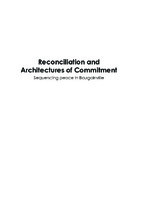Reconciliation and Architectures of Commitment: Sequencing peace in Bougainville
| dc.contributor.author | Braithwaite, John | |
| dc.contributor.author | Charlesworth, Hilary | |
| dc.contributor.author | Reddy, Peter | |
| dc.contributor.author | Dunn, Leah | |
| dc.date.accessioned | 2013-11-14 00:00:00 | |
| dc.date.accessioned | 2020-04-01T14:52:42Z | |
| dc.date.available | 2020-04-01T14:52:42Z | |
| dc.date.issued | 2010 | |
| dc.identifier | 459490 | |
| dc.identifier | OCN: 655896718 | en_US |
| dc.identifier.uri | http://library.oapen.org/handle/20.500.12657/33640 | |
| dc.description.abstract | Following a bloody civil war, peace consolidated slowly and sequentially in Bougainville. That sequence was of both a top-down architecture of credible commitment in a formal peace process and layer upon layer of bottom-up reconciliation. Reconciliation was based on indigenous traditions of peacemaking. It also drew on Christian traditions of reconciliation, on training in restorative justice principles and on innovation in womens’ peacebuilding. Peacekeepers opened safe spaces for reconciliation, but it was locals who shaped and owned the peace. There is much to learn from this distinctively indigenous peace architecture. It is a far cry from the norms of a ‘liberal peace’ or a ‘realist peace’. The authors describe it as a hybrid ‘restorative peace’ in which ‘mothers of the land’ and then male combatants linked arms in creative ways. A danger to Bougainville’s peace is weakness of international commitment to honour the result of a forthcoming independence referendum that is one central plank of the peace deal. | |
| dc.language | English | |
| dc.subject.classification | thema EDItEUR::N History and Archaeology::NH History | en_US |
| dc.subject.classification | thema EDItEUR::J Society and Social Sciences::JP Politics and government | en_US |
| dc.subject.classification | thema EDItEUR::J Society and Social Sciences::JP Politics and government::JPF Political ideologies and movements | en_US |
| dc.subject.other | politics and government | |
| dc.subject.other | papua new guinea | |
| dc.subject.other | peace | |
| dc.subject.other | history | |
| dc.subject.other | autonomy | |
| dc.subject.other | women | |
| dc.subject.other | independence | |
| dc.subject.other | bougainville island | |
| dc.subject.other | Australia | |
| dc.subject.other | Peacebuilding | |
| dc.title | Reconciliation and Architectures of Commitment: Sequencing peace in Bougainville | |
| dc.type | book | |
| oapen.identifier.doi | 10.26530/OAPEN_459490 | |
| oapen.relation.isPublishedBy | ddc8cc3f-dd57-40ef-b8d5-06f839686b71 | |
| oapen.pages | 161 | |
| oapen.place.publication | Canberra | |
| oapen.remark.public | Relevant Wikipedia pages: Australia - https://en.wikipedia.org/wiki/Australia; Autonomous Region of Bougainville - https://en.wikipedia.org/wiki/Autonomous_Region_of_Bougainville; Bougainville Island - https://en.wikipedia.org/wiki/Bougainville_Island; Papua New Guinea - https://en.wikipedia.org/wiki/Papua_New_Guinea; Peacebuilding - https://en.wikipedia.org/wiki/Peacebuilding | |
| oapen.identifier.ocn | 655896718 |

